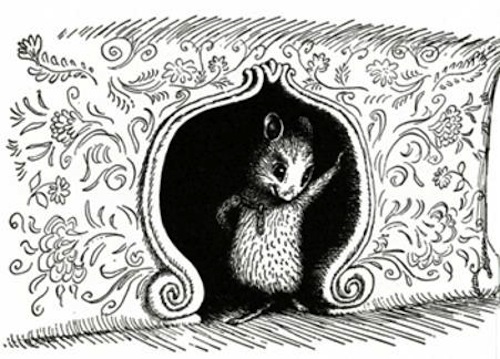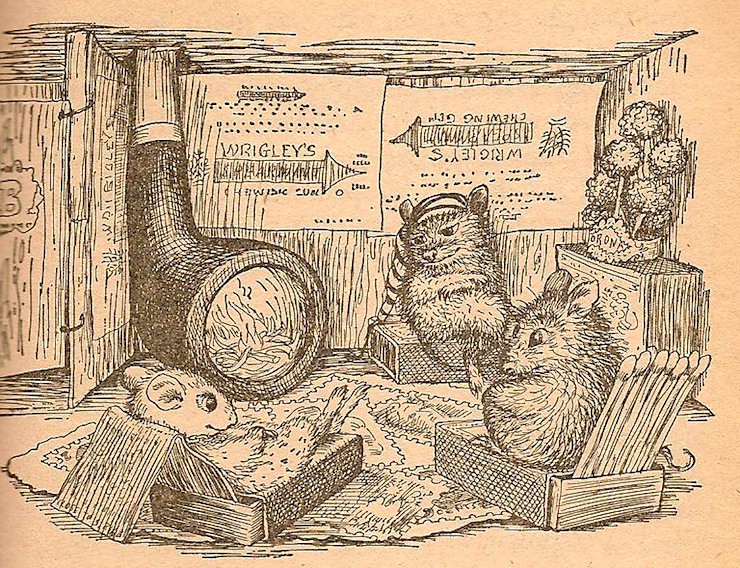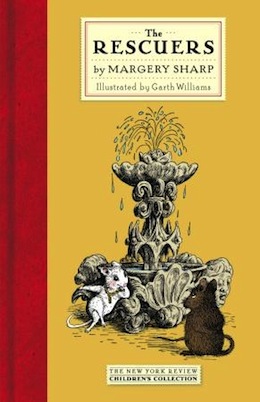Friendly mice—both talking and non-talking—had become a staple of children’s fiction by the 1950s, featuring in everything from historical parodies (Robert Lawson’s Ben and Me), wistful and mildly irritating stories of contemporary New York City (E.B. White’s Stuart Little), secondary fantasy worlds (the Narnia series), and even films (Cinderella). Friendly, comforting, non-talking rats and mice were also a staple of fictional prisons and solitary confinement, played with even in novels where the prisoners are not exactly prisoners (Frances Hodgson Burnett’s A Little Princess). In The Rescuers, Margery Sharp decided to combine both ideas, taking a look at friendly prison mice from the mouse point of view.
Talking mice, of course.
Margery Sharp was a minor short story writer and novelist who had published in Punch and managed to have a few of her novels adapted into now forgotten films when she sat down to write The Rescuers in the 1950s. Her World War II experience of contributing to the war effort despite a complete lack of relevant experience, training, or inclination helped shape her story of three little mice who, with a nearly complete lack of relevant experience, training or inclination, set out to rescue a Norwegian poet from prison. It was not, Sharp later claimed, written for or intended for children. Publishers in the U.S., however, took one look at the short length of the book and the talking mice, and sent it directly to the children’s section and the talented hands of Garth Williams, who illustrated the book and some of its sequels in between his work for the Little House books.
If you are wondering what, exactly, a Norwegian poet could possibly have done to get himself thrown into such a terrible, dark place as the Black Castle, well, the mice aren’t quite sure, but one of them suggests that it might have happened because the poet writes free verse. Usually the mice are content to just give prisoners a touch of comfort and companionship, in fulfillment of their traditional duties, but in this case, the Prisoners’ Aid Society, led by the redoubtable Madam Chairwoman Mouse, wants to do something more. Recognizing that no mouse can possibly cheer anyone up in the Black Castle—it’s a very depressing place—she wants to rescue him instead. The listening mice have doubts—many doubts. But Madam Chairwoman Mouse has a secret plan: Miss Bianca.

Miss Bianca is an aristocratic and—dare I say it?—overly pampered little mouse, so pampered and sheltered, indeed, that she is not even afraid of cats. She lives with the Ambassador’s son in a Porcelain Pagoda with a real fountain with real water, and, we learn, is fed cream cheese. To be fair, her life is not just lying around, looking beautiful—she also writes poetry. She is also, although she doesn’t admit it, rather lonely. She is not at all the sort of person one would choose for a dangerous mission to a Black Castle, but her pampered position, which includes the ability to fly to Norway on a real plane without difficulty, does make her the perfect sort of mouse to establish contact with Norwegian mice and find a little mouse capable of speaking to the Norwegian prisoner.
I must say this all seems tremendously overcomplicated—my assumption is that the poet doesn’t actually need to talk to the mice at all, but merely be able and willing to step out once an escape hole shows up, but this is a complicated novel, if short, so go with it.
Anyway, Bernard, a practical minded mouse from the—gasp—Pantry—agrees to contact Miss Bianca, who agrees to recruit a nice Norwegian mouse. This turns out to be practical, boat oriented Nils, who is able to teach Miss Bianca a lesson or two. And with that, the three of them are off to the Black Castle and a poet who may have dared to write free verse. You need to be careful about those sorts of things.
For such a short book, it’s very crowded with both incident and realistic depictions of long, slow tedious periods of waiting for something to happen, or being unsure of what to do next. Miss Bianca often tidies up, which serves both as distraction and a stress reduction technique. Sometimes she makes flowers out of sugar, bits of paper, or cheese, both to pass the time and keep up everyone’s spirits. Nils and Bernard explore the Black Castle when they can, although the presence of a dangerous cat does put a bit of a damper on this. There’s also happier moments—rides on carts filled with plenty of crumbs for mice to nibble on, watching the river, an exciting boat ride, a touch—just a touch—of light flirtation and growing love between the elegant Miss Bianca and working class Bernard, and a just slightly coincidental bit when Miss Bianca and Nils just happen to run across the toy sailboat which just happens to be owned by the boy that Miss Bianca lived with. It’s still properly stocked with sugar, and using it certainly saves the mice considerable time.
My favorite bit, however, may well be the end, where—spoiler alert!—despite strong mutual feelings of deep affection, Bernard and Miss Bianca decide to go their separate ways, determined to put personal responsibility and careers first. What’s pretty amazing here is that this works, bringing both of them not just personal satisfaction, but actual happiness. Children’s literature had, of course, frequently stressed the importance of personal responsibility and keeping promises, but a 1959 book assuring young readers that choosing career over love would bring a woman happiness was considerably more unusual, even revolutionary.

But then again, this is not really the story of three spy mice, but rather the story of how the pampered housemouse Miss Bianca leaves her sheltered home for a career—even if that career ends up leading her right back to that pampered home. And interestingly enough, Miss Bianca ends up succeeding precisely because of her carefully nurtured, explicitly feminine qualities: she’s able to outwit the very dangerous cat through a combination of wit, charm, and, above all, politeness: skills she nurtured in the Porcelain Pagoda. The entire adventure does not so much add to her skills as it broadens her outlook, making her better able to do her job.
Margery Sharp initially intended to leave her mice there, giving her closing paragraphs, summing up the later lives of Nils, Bernard and Miss Bianca, a certain air of finality. The Rescuers proved popular enough, however, that Sharp eventually churned out a nine book series, with the last book, Bernard into Battle, appearing shortly after the release of the 1977 Disney film. Sharp credited the film with increasing interest in her books. Eventually, however, all but The Rescuers were out of print again.
Mari Ness lives in central Florida.










